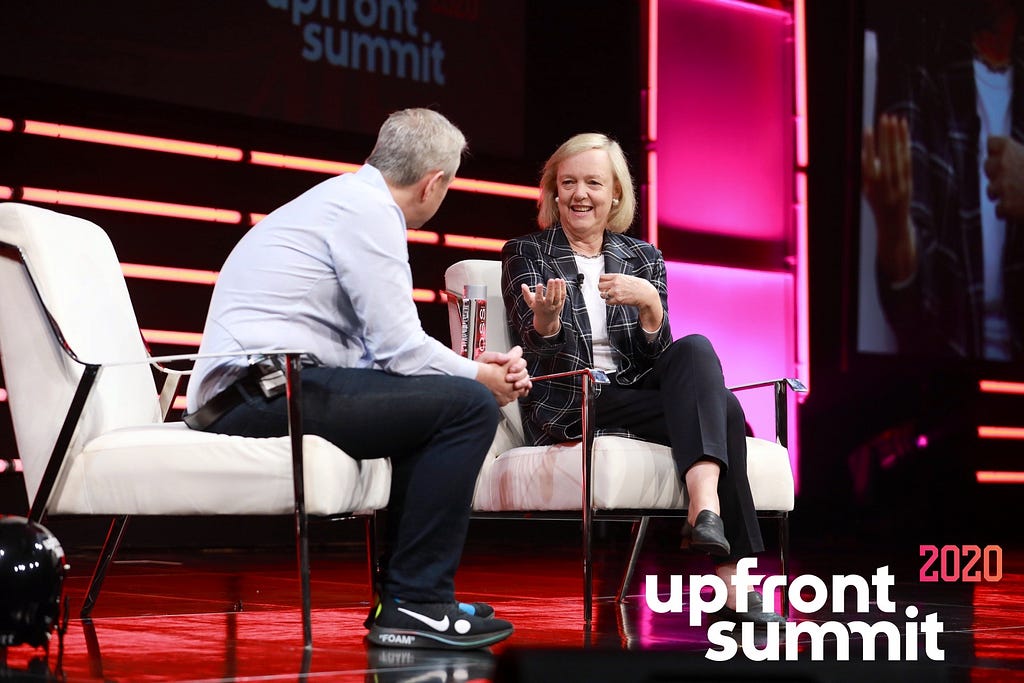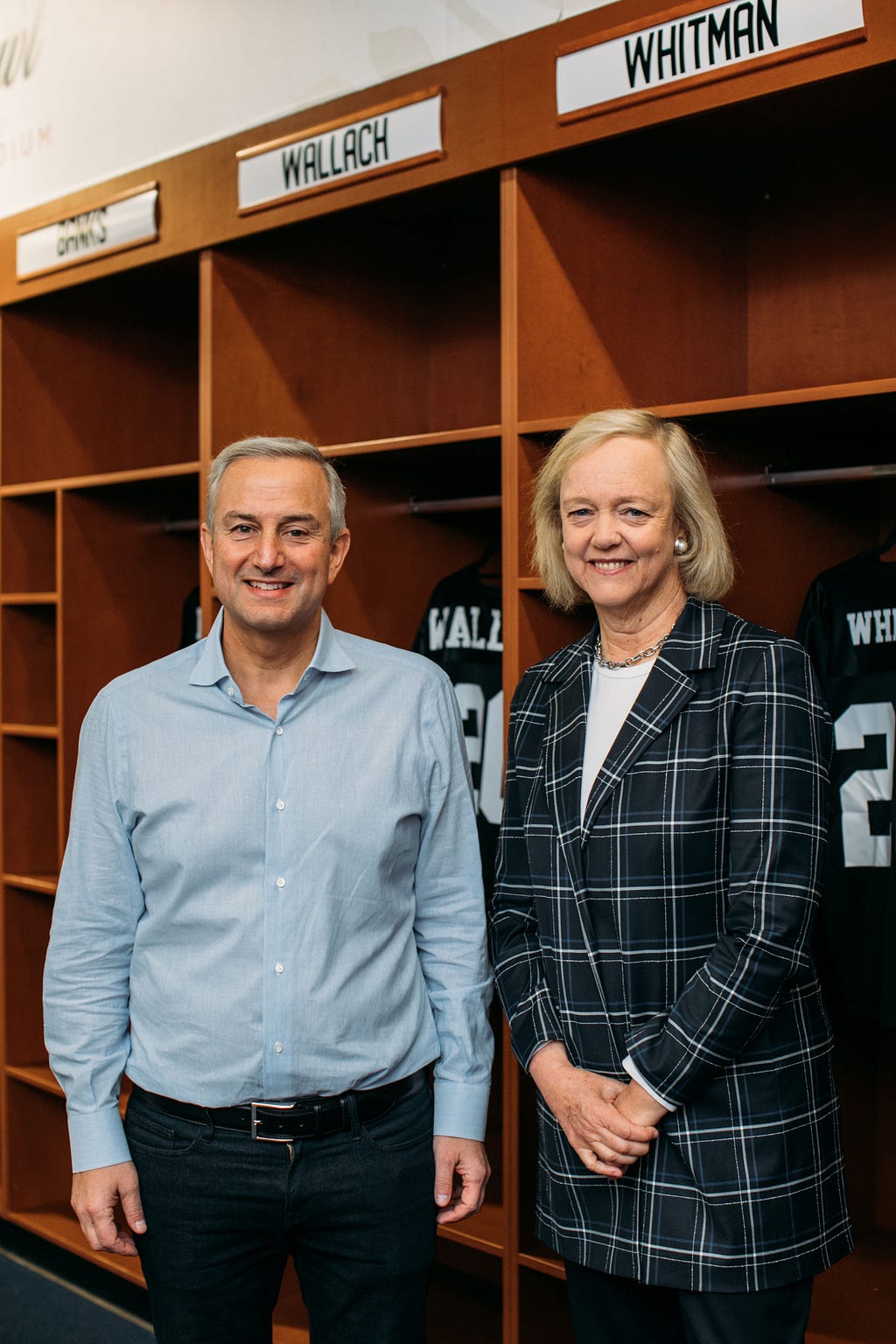
Every year, a personal Upfront Summit highlight is getting to sit down with experts in a field I care about. Sometimes that’s venture capital generally (like last year’s conversation with Reid Hoffman) and sometimes it’s in a space where I’ve invested (like mobility and city innovation with Bird’s Travis VanderZanden, one of our portfolio founders.)
I’ve spent a lot of my career thinking about digital and online video (with investments in companies like Maker Studios) so for that reason amongst many, I was excited to open the Upfront Summit a few weeks ago by interviewing Meg Whitman about Quibi and the digital media space.
Of course you’ve probably known of Meg as a business leader for many years, formerly as President and CEO of Hewlett Packard and the CEO of eBay before that, but since late 2018 she has been the CEO of Quibi (joining founder Jeffrey Katzenberg as the first employee). Between the heavy hitters at the helm, the more than $1.4B raised (more on that later), and the A-list names they’ve signed up for their first batch of content, they’ve certainly raised a lot of expectations and more than a few opinions. So I was excited for the audience to have the chance to hear from Meg in advance of Quibi’s April 6th launch.
I encourage you to watch the entire 30 minute video (below or here) both for insights into Quibi and understanding how a leader like Meg thinks about innovation, but I’ll also pull out a few highlights.
Why (and who) she thinks will pay for premium Quibi content
In a world of Netflix, Hulu, HBO, and YouTube, why would a customer choose to pay the $4.99 monthly subscription (or $8 ad free) for Quibi? Meg shared the perspective that Quibi is targeting a different kind of viewing experience (mobile-only video, which she say is only 10% of the viewing for other streaming services and virtually none during the day) and a different kind of content than what exists currently.
They’re primarily thinking about 7 AM — 7 PM mobile viewing of movies, lighter scripted and unscripted programming, and daily news/sports/politics, in the kinds of 10-minute content chunks you can consume on your commute or waiting at the dentist. Hence, her analogy of content like “The Da Vinci Code” which had 464 pages and 105 bite-sized, fully realized chapters. In essence, you’re not intimidated by the size of each episode so you dig in and might just read 8 chapters in a sitting before realizing you read 35 pages. And so it is with video.
(Quibi = “quick bites”). But unlike some of the existing mobile video on YouTube or IGTV which typically costs at most $1-5K/minute to produce, Quibi is focusing on high-quality production value content, spending up to $100K/minute on some programming (in line with typical streaming services like Netflix.)
“We would argue that our movies are world-class movies, just designed entirely for mobile.”
She also spoke about how they’ve seen premium content creators respond creatively to Quibi’s unique portrait — landscape format, and how they’re banking on what could be seen as a constraint to really produce unexpected, innovative content. For example, she spoke about how Steven Spielberg wanted to create a horror-based program that viewers could only watch at midnight. To time-restrict content requires an entirely new platform, one that only Quibi can support to date.
How Quibi is a technology platform first and then a content platform
Being an investor in LA and having seen a decade’s worth of video startup ideas, one of the reasons many video startups fail is because they think they can just distribute content online the way they’ve done it offline for a hundred years, without the innovation of technology. (And of course there are the Silicon Valley video startups who think it’s all about the tech and ignore the storytelling.)
Meg spoke about how Quibi first built out the technology platform and only then exposed it to content creators, and how technology is primary to the platform both in content creation as well as how customers will experience the content. That includes things like:
- Structure of the “turnstile” content — the content needs to be originally filmed and edited to deliver a seamless portrait and landscape edit, with the sound synced. This is an entirely new way of filming
- Personalization — to provide a curated feed new each day, they’re not just tagging every piece of content, they’re metatagging each frame of content to get viewers what they want, faster
- Interactivity — by designing or mobile consumption, they can eventually take advantage of every aspect of the phone including the camera, the touchscreen, the gyroscope, etc.
“There’s a long history in Los Angeles and Hollywood of technology enabling new ways to tell stories … We’ve created a really interesting technology platform that has inspired creators to do things in a completely different way. ”
She also spoke about the importance of 5G and why they think Quibi will be a perfect use case for the technology.
Why they raised so much initial funding
As I said in the interview, we at Upfront come from the land of small first rounds of financing. But Quibi has raised $1.4 billion and counting, before they’ve ever released a piece of content (I jokingly called it a $1 billion seed round). Why?
Meg shared their reasoning that Quibi would face two big challenges. First, given their unique format, they would have no existing library of content. But when you’re serving up 10 minute bites of content you can’t launch with just four shows. So they felt they needed to invest heavily in creating a breadth of high-quality content from day 1.
Second, no one had ever heard of Quibi, so they felt they needed to spend a lot of money on marketing to build the brand and awareness. If you watched the Oscars recently, you probably saw ads for a few Quibi shows — definitely a big and expensive promotional bet for a “startup”.
“We decided that to give ourselves a real fighting chance to make this work, we had to raise enough money to be able to create, at launch, a completely immersive experience.”
April’s launch will give us a lot more insight into Quibi’s big bet but I appreciated having the chance to hear Meg’s vision for the service. I hope you’ll enjoy the interview as much as I did.

Why Meg Whitman is Betting on Quibi as“The Da Vinci Code of Content” was originally published in Both Sides of the Table on Medium, where people are continuing the conversation by highlighting and responding to this story.
